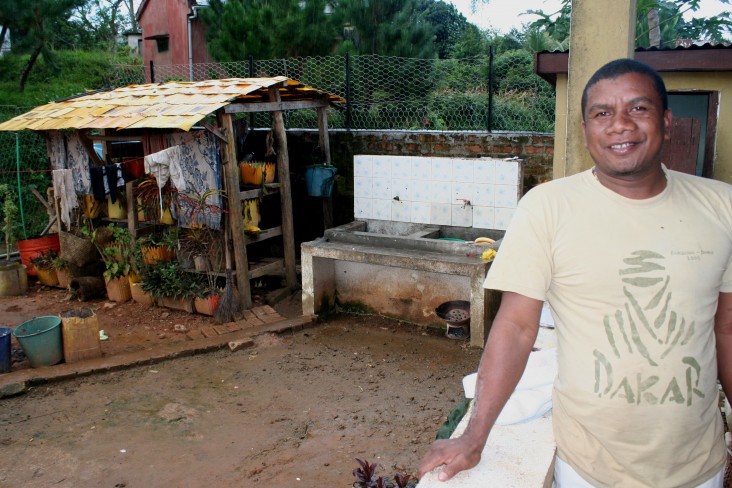
Sept. 2014—Not too long ago, residents in eastern Madagascar gained access to safe drinking water in their own homes—a development that has significantly improved their health and daily routine, not to mention the convenience of onsite plumbing in the small village.
A USAID water project arrived in eastern Anivorano in 2010 and completed construction of a water supply facility in mid-2011. Then, a competitive bid was launched for a company to manage the system, including installing pipes to connect individual homes to the new system. Entreprise Velo won the bid and signed a five-year contract in late 2011, which marked the inception of the new system.
There was no water tap in the village before the project arrived. Seven unprotected water wells were dug in Anivorano in 2008 and, in 2010, only one was functional but the water was very contaminated.
One of the first villagers to take advantage of the new system was Aimé Randrianantenaina, also known as Rabetsy.
A migrant from the southern town of Fianarantsoa, Rabetsy and family arrived in eastern Anivorano in 2011, a few months after the USAID-supported water project started in the area. He and his wife took turns getting up early in the morning and fetching water at the commune-run water supply point in the center of the village, where there was invariably a very long queue. Not only did they waste time waiting for their turn but, more often than not, a fight would start when people jumped the queue rather than wait their turn.
After USAID installed the water tap, but before Entreprise Velo came onboard to install home connections, a few annoyed people went back to fetching water from the river at the outskirts of the village. But Rabetsy did not follow them. He knew from the community health volunteers working for USAID how unhygienic the water from the river was and that it was a source of illnesses, particularly diarrheal diseases.
As soon as Entreprise Velo started working, it received many applications for home water connections, including one from Rabetsy. By the end of 2011, he paid the company to install water pipes up to his yard and a meter. He asked a local mason to build a washtub with a tap, a toilet with a septic tank system, and a bathroom with a small shower head. Now he had access to safe drinking water in his own yard, and the water flow and pressure were good.
And the monthly cost of water was only 41 cents for 1,000 liters. Gone were the days when he had to rise from bed at the crack of dawn, waste half of the morning lining up for water, and sometimes bicker with his neighbors.
“The people here should seriously think of using the tap water because it is safe, unlike the water from the river that is polluted and is a source of illnesses,” said Rabetsy.
Not only did USAID help the East Anivorano community rehabilitate and expand its water system, but it also helped the town develop a water and sanitation business plan to choose the water supply technology best suited to the local conditions, and an entrepreneur—Entreprise Velo—to manage the water system.
This public-private partnership between the community, the Ministry of Water and Entreprise Velo departs from the previous model of purely community-managed water systems and follows recommendations from Madagascar’s forward-looking water code. The recommendations include that water users contribute toward the cost of clean water, resulting in a more sustainable supply of clean water and adequate sanitation and a reinforced commitment of users to improving the health of their families.
More than 650 people in East Anivorano have gained access to safe drinking water with the new water supply system.
The USAID project, “Rural Access to New Opportunities for Health and Prosperity,” ran from March 2009 to June 2013 and was implemented by Catholic Relief Services. The project was designed to increase sustainable access to improved drinking water supply and sanitation facilities for poor and vulnerable populations in 42 communes in southern and eastern Madagascar.
LINKS
Follow @USAIDMadagascar, on Facebook, on Flickr, on YouTube







Comment
Make a general inquiry or suggest an improvement.